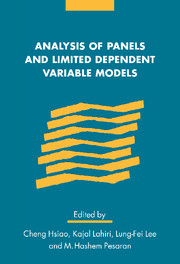Book contents
- Frontmatter
- Contents
- List of contributors
- Foreword
- Introduction
- 1 A note on left censoring
- 2 Autoregressive models with sample selectivity for panel data
- 3 Mixture of normals probit models
- 4 Estimation of dynamic limited-dependent rational expectations models
- 5 A Monte Carlo study of EC estimation in panel data models with limited dependent variables and heterogeneity
- 6 Properties of alternative estimators of dynamic panel models: an empirical analysis of cross-country data for the study of economic growth
- 7 Modified generalized instrumental variables estimation of panel data models with strictly exogenous instrumental variables
- 8 Expectations of expansions for estimators in a dynamic panel data model: some results for weakly exogenous regressors
- 9 Re-examining the rational expectations hypothesis using panel data on multi-period forecasts
- 10 Prediction from the regression model with one-way error components
- 11 Bayes estimation of short-run coefficients in dynamic panel data models
- 12 Bias reduction in estimating long-run relationships from dynamic heterogeneous panels
- CV of G.S. Maddala
- Index
12 - Bias reduction in estimating long-run relationships from dynamic heterogeneous panels
Published online by Cambridge University Press: 22 September 2009
- Frontmatter
- Contents
- List of contributors
- Foreword
- Introduction
- 1 A note on left censoring
- 2 Autoregressive models with sample selectivity for panel data
- 3 Mixture of normals probit models
- 4 Estimation of dynamic limited-dependent rational expectations models
- 5 A Monte Carlo study of EC estimation in panel data models with limited dependent variables and heterogeneity
- 6 Properties of alternative estimators of dynamic panel models: an empirical analysis of cross-country data for the study of economic growth
- 7 Modified generalized instrumental variables estimation of panel data models with strictly exogenous instrumental variables
- 8 Expectations of expansions for estimators in a dynamic panel data model: some results for weakly exogenous regressors
- 9 Re-examining the rational expectations hypothesis using panel data on multi-period forecasts
- 10 Prediction from the regression model with one-way error components
- 11 Bayes estimation of short-run coefficients in dynamic panel data models
- 12 Bias reduction in estimating long-run relationships from dynamic heterogeneous panels
- CV of G.S. Maddala
- Index
Summary
Introduction
In panel data models it is often of interest to estimate the average long-run effects of some exogenous variables (x) on a dependent variable of interest (y). In situations where T (the number of time periods) is sufficiently large there are four procedures that can be used to estimate this average effect (Pesaran and Smith (1995)). The first involves estimating separate regressions for each group and averaging the long-run coefficients over groups, which Pesaran and Smith refer to as the mean group estimator (MGE). The second procedure is to pool the separate regressions by imposing common slopes (but allowing for fixed or random intercepts), with the long-run effects estimated using standard fixed or random effects pooled regressions. The third is to average the data over groups and estimate aggregate time series regressions based on group averages. The last is to average the data over time and estimate cross-section regression based on long-time averages. In the static case, where the regressors are strictly exogenous and the coefficients differ randomly and are distributed independently of the regressors across groups, all four procedures provide consistent (and unbiased) estimates of the average (long-run) effects (Zellner (1969)). For some time it was wrongly believed that a similar result held for dynamic panel data models, namely that all the above four procedures yield consistent estimators.
- Type
- Chapter
- Information
- Analysis of Panels and Limited Dependent Variable Models , pp. 297 - 322Publisher: Cambridge University PressPrint publication year: 1999
- 28
- Cited by

